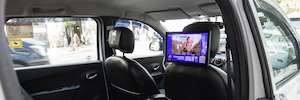Metro de Madrid estrena pantallas Led con el sistema inteligente de información al viajero integrado
La Comunidad de Madrid ha puesto en marcha en las estaciones de Estadio Metropolitano y Aeropuerto T1, T2 y T3, un nuevo sistema digital de información inteligente al viajero basado en pantallas planas y curvas con tecnología Led.
El nuevo sistema de información al viajero que acaba de poner en marcha la Comunidad de Madrid para facilitar la movilidad en el Metro de Madrid a través de pantallas con tecnología Led, se ha instalado en la estación de Aeropuerto T1-T2-T3 y que hoy y hasta el próximo 13 de diciembre recibirá con información específica a los participantes que acuden la Cumbre del Clima (COP25) en Ifema, a la que se prevé la asistencia de más de 20.000 personas.
Igualmente, este sistema también está operativo en la estación de Estadio Metropolitano, con gran afluencia de pasajeros cuando se celebran partidos y eventos en el estadio Wanda Metropolitano. El consejero de Transportes, Movilidad e Infraestructuras del Gobierno regional y presidente de Metro, Ángel Garrido, ha presentado esta iniciativa cuyo objetivo es facilitar el tránsito de viajeros en estaciones de gran afluencia.
“La singularidad de estas pantallas radica en que tienen la potencia y la versatilidad necesarias para ajustar los mensajes a las necesidades operativas -ha señalado Garrido durante la inauguración del sistema-. De este modo, aportan información útil al viajero y también contribuyen a agilizar la movilidad dentro de la estación y su entorno, evitando y aliviando situaciones de saturación”.
Tecnología en 360º
Las dos primeras estaciones en las que se ha aplicado esta tecnología cuentan con pantallas de grandes dimensiones en accesos, vestíbulos, barreras de peaje, e incluso se han instalado en sistemas con formato curvo en las columnas, hasta ahora algo inédito en Metro de Madrid, lo que permite ofrecer información en 360º.
El formato de estas pantallas Led de alta calidad permite ofrecer contenidos en dos o cuatro zonas diferenciadas, aportando información adaptada a la dirección de los viajeros; disponen de elementos antivandálicos y tienen un sistema de monitorización y control del estado de los parámetros de calidad de la emisión (brillo y color) y del contenido emitido para mostrar de manera dinámica la información oportuna en cada momento.
El sistema se integra en un gestor de contenidos habilitado en el Puesto de control central de Metro de Madrid, desde donde se emitirán los mensajes, informando en tiempo real de la dirección al andén que corresponda, de la prohibición de pasar, recomendar la compra anticipada de billetes, la distribución a lo largo del andén o de desalojo, así como sobre incidencias en la red del suburbano, etc.
La estación de Estadio Metropolitano cuenta con seis pantallas Led instaladas en el interior y, próximamente, se ubicarán otras tres pantallas de gran formato en el acceso exterior. Por su parte, la de Aeropuerto T1-T2-T3 dispone de cuatro pantallas Led en el interior y, también en breve plazo, se implantará un conjunto de pantallas sobre las máquinas expendedoras de títulos de transporte para ofrecer información asociada a estas máquinas.
Como ha podido conocer este diario, la empresa Roura Cevasa, a través de su departamento de I+D+i, ha realizado la señalización digital de la estación Aeropuerto T1-T2-T3 y de Estadio Metropolitano, con mobiliario que aloja elementos digitales circulares y de las pantallas planas, que integran el sistema inteligente de información al viajero en tiempo real Deneva DS del especialista Icon Multimedia.
Preparado para el futuro
Este nuevo sistema de información al viajero supone una inversión de casi 400.000 euros y forma parte de la denominada Estación 4.0, un plan global de transformación digital “para conseguir mantener su alta calidad, ofrecer nuevos servicios demandados por los clientes y realizar una gestión de toda la red eficiente y eficaz acorde a los nuevos tiempos”, señalan desde Metro de Madrid.
Basada en la Industria 4.0, esta transformación digital del suburbano madrileño implicará tanto las estaciones como los centros de control y supondrá también nuevas redes de comunicaciones.
Así lo explicó el consejero Garrido: “en la Estación 4.0 estamos trabajando con tecnologías a diez años vista, como las cámaras que calculan el porcentaje de saturación de una estación, que detectan objetos abandonados o advierten de la caída de una persona a las vías. Porque Metro no es solo transporte: contribuye a una mejor comunicación, interacción y vertebración de nuestra sociedad, con la máxima eficiencia energética y las mínimas emisiones”.
Te gustó este artículo?
Suscríbete a nuestro RSS feed y no te perderás nada.
• Sección: Casos de estudio, DESTACADO, DESTACADO Caso Estudio, Digital signage, Display, Distribución señales, Publicidad dinámica







